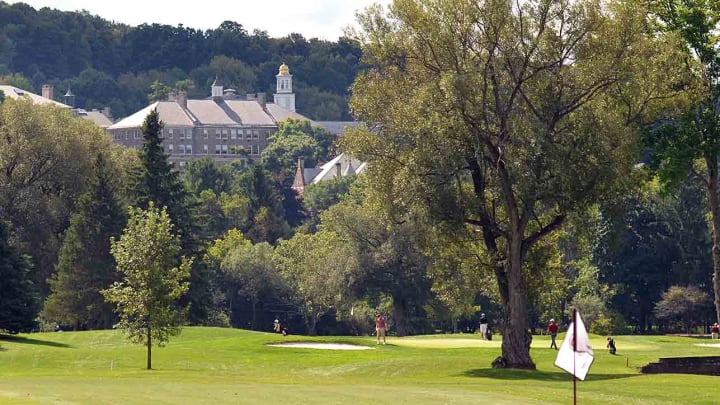Six College Courses Worth Seeking Out for Your Next Golf Trip

College golf is a grind. 36-hole tournament days, 5:45 a.m. range sessions before class, and cutthroat qualifying rounds against teammates that extend into dusk: If you have a former or current collegiate golfer in your life, you’ve heard it all. As a college player, one of the places you’ll spend the most hours is your school’s home course. Many college teams practice at local country clubs or public golf courses in their area, however, lucky squads have access to their very own campus-operated track. Either way, its contours and undulations become etched in your mind as you and your teammates become familiar with every blade of grass during daily practices.
University golf courses are underrated as some of the country’s coolest destination golf spots. With a compelling combination of challenging terrain, history, and accessibility, you won’t want to overlook a college town for your next buddies trip. These courses are meant to train and test some of the sharpest young golfers around the country, while also offering a fun loop for locals. Here's a half-dozen that are worth a visit for players of all skill levels who appreciate the rich context that can be found at a university course.
Yale Golf Course
When you think of legendary college golf courses, there is one particular venue that should immediately pop into your mind, and for good reason. Yale Golf Course opened up for play in 1926, after world-renowned golf course architect Seth Raynor and USGA founder Charles Blair Macdonald teamed up to convert a 700-acre piece of wooded, swampy terrain in New Haven, Connecticut.
The layout of the Yale Course is as vast and dramatic as a routing can get. Massive greens, blind shots, and bunkers that could bury you mark the key elements of the beloved New Haven course. The 213-yard 9th “Biarritz” hole is a par-3 that is hard to ever forget playing, as a deep gully intersects the middle of the 64-yard deep green, which is protected by a water hazard and treacherous bunkers to the right and left. The course pushes you to your physical limit, not only by demanding precise shotmaking, but also through the sheer scale of the golf course and the difficulty of the walk. It’s a rarity, but you’ll be smiling as Yale’s grand features beat you up, inside and out. Yale Athletics announced last year that they have entrusted famed golf course architect Gil Hanse with an upcoming restoration, and the 22- to 24-month long project will reinvigorate Yale’s most significant design elements with Raynor’s and Macdonald’s original plans in mind.
How to play it: Yale Golf Course is currently closed for the season, but it is generally open to the public for play. If you’re accompanied by a Yale University affiliate (a member of the faculty, staff, or an alumni) the greens fees are reduced.
Taconic Golf Club at Williams College
Taconic Golf Club is part of the Williams College campus—an elite small liberal arts college in the Berkshire mountains of Massachusetts—and it boasts some of the most beautiful vistas of any college course. Taconic has gone through some dramatic changes since its inception in 1896, when it was transformed from farmland to a nine-hole golf course. Designed by the Boston-based architecture company Stiles and Van Kleek, the course was extended to 18 holes in 1928, and revised in the 1950s to play as a par 71. Hanse then took the reins in 2008, as he has done for many renowned courses around the world. He re-established Stiles and Kleek’s original style by removing 1,000 trees from the property and shifting bunkers to appropriate locations for the modern golfer.

A few quaint details give Taconic a distinct charm: On the 4th hole, for example, a birdhouse stands tall in the middle of the pond, cleverly labeled “Suggestion Box.”
How to play it: Unaccompanied guests at Taconic can play for a greens fee of $200 (which includes a cart). If you are visiting with a student, a member, a Williams alum or spouse, or an employee of the College, you'll pay less.
University of Michigan Golf Course
Imagine having an Alister MacKenzie golf course in your backyard as a college student. Well, University of Michigan students don’t have to: The school’s golf course is just minutes away from campus and was indeed designed by the famed architect, most widely known as the mind behind Augusta National. Although only 6,700 yards, the course—which regulars often refer to as “The Blue”—is no walk in the park. Elevation changes and slick, well-protected greens are the course’s real defenses. If the University’s spirit doesn’t emanate when you first enter the town of Ann Arbor, it will become apparent on the drive into The Blue, where you'll get a breathtaking view of "The Big House," the largest football stadium in the country.
How to play it: Guests at The University of Michigan Course can play for $135 on weekdays and $160 Friday through Sunday. The deal comes with some freebies: You’ll receive a logoed hat or towel and a lunch voucher along with your tee time. Of course, if you can track down an alum, student, faculty member, or other affiliated member of the course, you’ll save.
Seven Oaks Golf Club at Colgate University
Tucked away in the small town of Hamilton, New York, is Seven Oaks Golf Club, Colgate University’s golf course. The history of golf at Colgate dates back to 1916, when Hamilton townsfolk and Colgate University faculty members banded together with the goal of creating a golf club. A nine-hole course behind Colgate’s student dorms was first built in 1917, called Seven Oaks in honor of the Colgate family tree. The onset of World War II postponed plans to construct an 18-hole course, but when efforts were finally set in motion and funds were acquired, Robert Trent Jones Sr. took control of the new Seven Oaks design.

According to Colgate University head golf coach Keith Tyburski, recent additional renovations to the course have made it more playable for mid-handicappers, but trickier for his scratch-level college players. “The defense of the golf course has shifted from its length to the greens,” Tyburski said. “The greens are large, expansive and undulating. You can add 15 or more yards to a hole with a back pin placement, many of which are on upper tiers or sections of the greens.”
How to play it: Seven Oaks is open to the public for $35 Monday through Thursday, $50 on Fridays, and $85 on weekends and holidays.
Duke University Golf Club
Not only is Duke Golf Club fit for a top Division I golf program, it also boasts a fascinating history that will only supplement the already fantastic playing experience. At the conclusion of World War II, the University hired Robert Trent Jones Sr. to design its course. He was quickly becoming one of the most widely respected architects in golf, and Duke wanted its home track to be a world-class championship venue. Five years after the course finally opened for play in 1957, it landed as the host site of the 1962 NCAA Golf Championship. Rees Jones, Jones Sr.’s eldest son, competed in this very championship for Yale University.
The Jones legacy with Duke Golf Club doesn’t stop there: In 1994, Rees set out to renovate the University course, looking to re-emphasize the natural beauty of the property. Considering his own competitive experience with the golf course, he took great care in improving landing areas, green complexes, tee boxes and more. Now, Duke University Golf Club is known for its forced carries over snaking creeks and dramatic undulation throughout.
How to play it: The Duke Golf Club is open to the public for daily play, with greens fees set at $85 for Mondays and Tuesdays, $90 for Wednesdays and Thursdays, and $105 for Friday through Sunday tee times. JB Duke and Washington Duke Inn Guests play for a slightly reduced fee.
Ohio State University Golf Course (Scarlet)
Ohio State’s Scarlet Course, one of two courses at the University’s golf club, boasts a stacked roster of contributors to its praised design. Alister MacKenzie drew up original routing plans, but in 1938, Perry Maxwell oversaw the ultimate construction of the course after MacKenzie’s death. In 2005, major restorations commenced to convert the Scarlet back to MacKenzie’s vision. Jack Nicklaus, the Hall of Famer and Buckeye alumnus, oversaw this most recent project. It lengthened the course to 7,400 yards and added state-of-the-art practice facilities for Ohio State’s men’s and women’s golf teams. Expansive bunker complexes are one of the defining features of the course, which has now played host to several U.S. Open qualifiers as well as the Korn Ferry Tour’s Nationwide Children’s Hospital Championship.
How to play it: The Ohio State Scarlet course requires a bit more planning to play: You’ll have to track down a student, faculty member, staff member, or an affiliate of the University to accompany you while you play. Guests will pay $80 greens fees.
